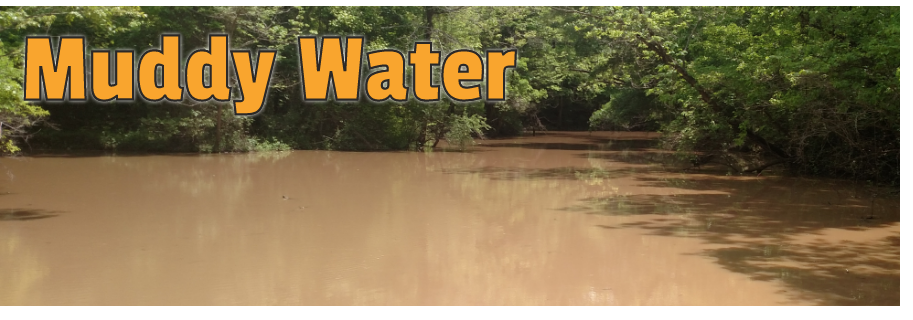Main Content

Muddy water is usually caused by suspended clay or other fine particulates that reduce the clarity of water. This condition can be persistent when water hardness is low, or when sediments are continuously disturbed by wind and waves, current, animals, or bottom-dwelling fish like catfish or common carp. A quick test can provide useful information; fill a mason jar, or similar container, 3/4 full of pond water and let it sit for 24-48 hours. If the water clears during this time, it is likely that some disturbance is keeping the sediment suspended in the water. If the water does not clear, then you likely have low water hardness, possibly in addition to a disturbance.
Livestock watering ponds are notorious for extremely muddy water due to the animals wading into the pond and disturbing the bottom. When practical, design livestock ponds so that the animals drink from external watering structures that are gravity-fed from the entirely fenced-off pond. This will keep the pond water cooler, cleaner, and healthier for the animals and allow the pond to support good fishing in addition to drinking water. If external structures are impractical, reinforce a section of the pond bottom with geotextile fabric covered with gravel and fence the rest of the pond off so that the animals can only enter the water on the gravel bed. This will reduce muddy water and still allow the animals direct access to the water, albeit in a smaller area. For more details on livestock watering practices, read
FSA3128 - Watering Systems for Cattle Ponds.
Another common cause of "muddy" water is planktonic algae, though they usually produce a brownish-green to bright-green appearance. The same jar test as described above can indicate whether potentially harmful blue-green algae (cyanobacteria) are abundant, or whether the majority of the bloom is beneficial green algae. For the algae test, cap the mason jar and store it in a refrigerator overnight. If by morning a bright green ring or layer of algae has formed at the top of the water in the jar, then blue-green algae are present. If all of the algae has formed a layer at the bottom of the jar, then there is no or very little blue-green algae in the pond. While flocculants described below can partially clear planktonic algae blooms, there are other methods that can be more effective. See the
Aquatic Weeds page for more information on algae bloom management.
Flocculants such as gypsum (calcium sulfate) and alum (aluminum sulfate) can increase water hardness which can help clear water and make it more suitable for fish. Hardness is the concentration of divalent ions (elements with 2+ electrical charge) like calcium and magnesium in water. Fish need a minimum of about 5 mg/L of calcium (greater than 20 mg/L is preferred) for egg survival, healthy bone development, and proper osmoregulation. Good concentrations of hardness also help keep water clear. Clay particles are tiny and negatively charged. Without positively charged ions like calcium and magnesium, clay can stay suspended in the water indefinitely. Muddy ponds are generally less visually appealing, they get hotter during the summer, and they are less productive. While flocculants can be applied any time of year to help clear muddy water, it’s best to apply them in the fall if possible. Flocculants will clear water and sink nutrients to the bottom of the pond. This combination can lead to increased rooted aquatic weed growth. While most application rates for gypsum are based on the amount necessary to clear clay turbidity, it is safe to use the same application rates solely to enhance hardness. Rates of 1,000 to 2,000 lbs of gypsum per acre-ft are commonly recommended to reduce clay turbidity. Alum is a highly effective flocculant that only requires 100 to 200 lbs per acre-ft to clear most ponds. However, alum also decreases water pH and can cause fish kills in ponds with alkalinity below 20 mg/L. Therefore, alum treatments are only recommended in ponds with a minimum of 20 mg/L of alkalinity, 50 mg/L preferred.
Additional resources:
-
FSA3128 - Watering Systems for Cattle Ponds
-
SRAC 0460 Control of Clay Turbidity in Ponds
-
SCS 2013 02 Water Management - Clearing Cloudy and Muddy Water in Ponds and Lakes